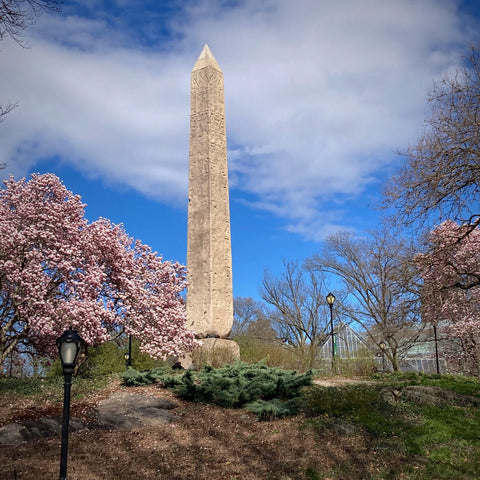
Standing near the Eastern edge of Central Park, just behind the Metropolitan Museum of Art, is the Ancient Egyptian obelisk known as Cleopatra's Needle. It is over 3,000 years old.
During a visit to Egypt eleven years ago, our guide in Alexandria left us with this exhortation: "Please ask your government to send-back the obelisk."
Actually, there had been a pair of obelisks in Alexandria: one which went to London and its mate which went to New York. In 1819, Muhammad Ali Pasha, the Ottoman Viceroy of Egypt, presented the two monuments as gifts—one to the Brits, the other to the Americans. At that time, one obelisk was still standing; the other had toppled-over (probably during the Crete Earthquake of 1303 AD) and was half buried in the Egyptian sands.
The obelisks—decorated with incised hieroglyphics—had been carved in Cairo (called "Heliopolis" by the Greeks) some 1500 to 1200 years BC. They bore the names of pharaohs Thutmose III and Ramses II (the latter considered the greatest, most powerful, of all the pharaohs). During the century before Christ, the obelisks were moved to Alexandria (no small feat) by Cleopatra VII to decorate a temple built to honor her lover, the Roman general Mark Antony. In later years, the Emperor Augustus Caesar defeated Mark Antony, eliminated any trace of him, and renamed the temple the Caesareum after himself. In any case, the obelisks remained in Alexandria for over 2,000 years. From at least 1200 AD, the obelisks were referred to as "Cleopatra's Needles."
Once gifted to England and America, the thorny issue became, "How to move them thousands of miles—to London and New York?" For over fifty years, they remained in Alexandria, the shipping costs being so great. Eventually, the Egyptian property owner threatened to chop them up to use as building material. They were picked-up in 1878. The British obelisk was installed on the (newly-built) Embankment, along the Thames, and the American obelisk was installed behind the (newly-built) Metropolitan Museum. The ordeal of shipping them—ever so carefully—across the sea resulted in two books, written by the men who oversaw their transport.

